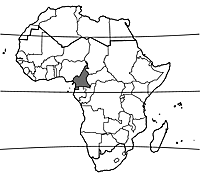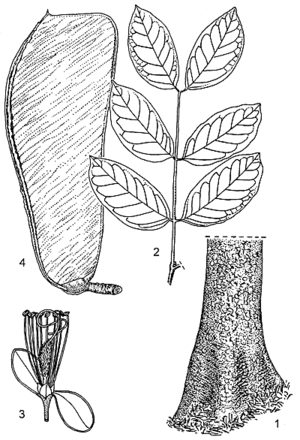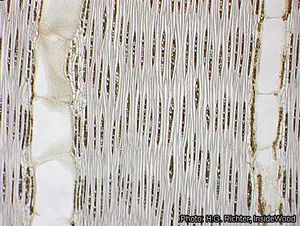Brachystegia cynometroides (PROTA)
Introduction |
Brachystegia cynometroides Harms
- Protologue: Bot. Jahrb. Syst. 26: 267 (1899).
- Family: Caesalpiniaceae (Leguminosae - Caesalpinioideae)
Origin and geographic distribution
Brachystegia cynometroides has a small area of distribution, in western Cameroon and Equatorial Guinea (Bioko), possibly also in the south-western part of the Central African Republic and in northern Gabon.
Uses
The wood of Brachystegia cynometroides, called ‘naga’ or ‘okwen’ in trade, is used for flooring, interior carpentry, joinery, panelling, stairs, wooden frames, furniture, cabinet work, veneer and plywood. It is suitable for construction, interior trim, ship building, vehicle bodies, boxes, crates and fibre board.
Production and international trade
In Cameroon, where production of the wood of Brachystegia cynometroides is officially promoted, production in 1995 amounted to 1.9% of the timber produced, or about 51,300 m³. Most of the wood is used within the country; between 1998 and 1999, about 7500 m³ was exported from Cameroon to Europe and the United States. Statistics on trade are not available because the timber of Brachystegia cynometroides is often sold in mixed consignments together with the timber of other Brachystegia spp. and of several other genera such as Aphanocalyx and Bikinia.
Properties
The heartwood of Brachystegia cynometroides is yellowish brown or reddish brown, often with a purplish or coppery hue; it is clearly demarcated from the white, very pale brown or yellowish, up to 15 cm thick sapwood. The grain is straight to interlocked, texture medium to coarse. The wood is often finely streaked on quarter-sawn surfaces.
The wood is medium-weight, with a density of (530–)600–730 kg/m³ at 12% moisture content, and moderately hard. It air dries fairly rapidly and well, but some sources report that its drying rate is slow to normal with a tendency of distortion and checking. The rates of shrinkage are moderate, from green to oven dry 4.2–5.4% radial and 6.5–7.9% tangential. Once dry, the wood is moderately stable in service.
At 12% moisture content, the modulus of rupture is 98–144 N/mm², modulus of elasticity 8920–11,860 N/mm², compression parallel to grain 43–63 N/mm², shear 7–8.5 N/mm², cleavage 10–18 N/mm and Chalais-Meudon side hardness (1.7–)2.4–5.1.
The wood is fairly easy to saw and work with both hand and machine tools. Although the silica content is low ( less than 0.05%), the wood may have a blunting effect on saws and cutting tools due to the presence of crystals. It is recommended to saw boles as soon as possible after felling, as green wood is much less abrasive and has less tendency to carbonize on sawing. For planing, a low cutting angle (15°) is required. The use of a filler is recommended to get a smooth finish. Nailing and screwing tend to cause splitting, and pre-boring is recommended. The wood glues well, although the occasional presence of wet pockets may cause difficulties. It takes paint and varnish well. The peeling and slicing properties are satisfactory, although the common presence of interlocked grain and the coarse texture may lead to rough or woolly surfaces. The turning and carving properties are variable. The wood is not durable to moderately durable, being liable to attack by fungi, termites, pinhole borers and marine borers. The heartwood is resistant to impregnation with preservatives, the sapwood is easily impregnated.
The wood contains 39.5–45% cellulose, 32–35% lignine, 15.5–18% pentosan, 0.7–1.2% ash and very little silica. The solubility is 1.7–2.5% in alcohol-benzene, 1.5–3.0% in hot water and 13.7–17.6% in a 1% NaOH solution.
Adulterations and substitutes
The wood of Brachystegia cynometroides can be replaced by the woods of Brachystegia eurycoma Harms or Brachystegia leonensis Burtt Davy & Hutch., which have similar properties and are also traded as ‘naga’ or ‘okwen’.
Description
- Deciduous, medium-sized to fairly large tree up to 35(–40) m tall; bole branchless for up to 15 m, often bent, twisted or sinuous, but sometimes straight and cylindrical, up to 180 cm in diameter, with buttresses up to 4(–5) m high or with rounded thickenings at base; bark surface smooth to rough, peeling in scales leaving sinuous grooves especially towards base of the bole, orange-red or brownish, inner bark c. 1.5 cm thick, fibrous, reddish, turning brown on exposure, exuding a sticky, white gum; crown broadly spreading, open, with thick, twisted branches; twigs glabrous.
- Leaves alternate, paripinnately compound with (2–)3 pairs of leaflets; stipules persistent as hard scales; petiole swollen at the base, rachis 10–15 cm long; petiolules c. 5 mm long; leaflets opposite, obliquely oblong to elliptical, 6–8 cm × 3–4 cm, cuneate to obtuse at base, short-acuminate at apex, leathery, glabrous, pinnately veined with 6–9 pairs of lateral veins.
- Inflorescence a terminal or axillary, short panicle 3–4 cm long, with hairy branches.
- Flowers bisexual, regular, small, at base with 2 obovate bracteoles c. 5 mm × 3 mm; pedicel 2–3 mm long, hairy; sepals 5, 1–1.5 mm long, with hairy margins; petals absent; stamens 10, free, c. 7 mm long; ovary superior, ellipsoid, with short stipe, hairy, style slender, coiled.
- Fruit an oblanceolate to obovate, flattened pod 20–25 cm × 8–10 cm, at a right angle to the stipe, smooth but slightly wrinkled, dehiscent with 2 woody valves, 2–4-seeded.
- Seeds large, disk-shaped.
Other botanical information
Brachystegia is a taxonomically difficult genus comprising about 30 species, distributed in mainland tropical Africa and South Africa, the majority of species occurring in southern tropical Africa, where they are characteristic of miombo woodland.
Anatomy
Wood-anatomical description (IAWA hardwood codes):
- Growth rings: 1: growth ring boundaries distinct.
- Vessels: 5: wood diffuse-porous; 13: simple perforation plates; 22: intervessel pits alternate; 23: shape of alternate pits polygonal; 26: intervessel pits medium (7–10 μm); 29: vestured pits; 30: vessel-ray pits with distinct borders; similar to intervessel pits in size and shape throughout the ray cell; (42: mean tangential diameter of vessel lumina 100–200 μm); 43: mean tangential diameter of vessel lumina ≥ 200 μm; 46: ≤ 5 vessels per square millimetre; (47: 5–20 vessels per square millimetre); 58: gums and other deposits in heartwood vessels.
- Tracheids and fibres: 61: fibres with simple to minutely bordered pits; 66: non-septate fibres present; 69: fibres thin- to thick-walled.
- Axial parenchyma: 80: axial parenchyma aliform; 81: axial parenchyma lozenge-aliform; 83: axial parenchyma confluent; 89: axial parenchyma in marginal or in seemingly marginal bands; 91: two cells per parenchyma strand; 92: four (3–4) cells per parenchyma strand.
- Rays: 96: rays exclusively uniseriate; (97: ray width 1–3 cells); 104: all ray cells procumbent; 116: ≥ 12 rays per mm.
- Storied structure: 118: all rays storied; 121: fibres storied.
- Secretory elements and cambial variants: (131: intercellular canals of traumatic origin).
- Mineral inclusions: 136: prismatic crystals present; 142: prismatic crystals in chambered axial parenchyma cells.
Growth and development
Brachystegia cynometroides flowers in April and fruits ripen in July. The roots are associated with ectomycorrhizae. N-fixing nodules have not been found.
Ecology
Brachystegia cynometroides usually grows in groups in primary and old secondary, humid evergreen forest and riverine forest, up to 200 m altitude, in regions with an annual rainfall of 1500–3000 mm and mean temperatures of 23.5–25°C and 1–2 dry months. It is less common in semi-evergreen forest. It can be found on various types of ferralitic soils and on sedimentary sandy or sandy clay soils.
Management
In forest in south-western Cameroon, trees with a bole diameter of more than 60 cm have been found at an average density of 0.13 trees/ha, and trees with a bole diameter of more than 15 cm at 0.33 trees/ha.
Harvesting
The minimum bole diameter for felling in Cameroon is 60 cm.
Genetic resources
In Cameroon Brachystegia cynometroides is classified as a timber resource of secondary importance, but it is promoted. Its limited export volume does not seem to cause a threat of genetic erosion, but Brachystegia cynometroides has a small area of distribution and therefore monitoring of the populations is recommended.
Prospects
The wood of Brachystegia cynometroides will remain of mainly local importance for indoor construction and joinery. It was exported from Cameroon for a few years, but exports declined rapidly, and its prospects on the international timber market are therefore less certain. Information is needed on its growth rates, natural regeneration, appropriate management and potential yield.
Major references
- Aubréville, A., 1970. Légumineuses - Césalpinioidées (Leguminosae - Caesalpinioideae). Flore du Cameroun. Volume 9. Muséum National d’Histoire Naturelle, Paris, France. 339 pp.
- Bolza, E. & Keating, W.G., 1972. African timbers: the properties, uses and characteristics of 700 species. Division of Building Research, CSIRO, Melbourne, Australia. 710 pp.
- CTFT (Centre Technique Forestier Tropical), 1953. Naga. Bois et Forêts des Tropiques 31: 27–30.
- Gérard, J., Edi Kouassi, A., Daigremont, C., Détienne, P., Fouquet, D. & Vernay, M., 1998. Synthèse sur les caractéristiques technologiques de référence des principaux bois commerciaux africains. Série FORAFRI. CIRAD-Forêt, France. 185 pp.
- Letouzey, R. & Mouranche, R., 1952. Ekop du Cameroun. Centre Technique Forestier Tropical, Nogent-sur-Marne, France. 81 pp. + 20 plates.
- Sallenave, P., 1964. Propriétés physiques et mécaniques des bois tropicaux. Premier supplément. Centre Technique Forestier Tropical, Nogent-sur-Marne, France. 79 pp.
- Savard, J., Besson, A. & Morize, S., 1954. Analyse chimique des bois tropicaux. Publication No 5, Centre Technique Forestier Tropical, Nogent-sur-Marne, France. 191 pp.
- Takahashi, A., 1978. Compilation of data on the mechanical properties of foreign woods (part 3) Africa. Shimane University, Matsue, Japan. 248 pp.
- Thirakul, S., 1983. Manuel de dendrologie. Centre National de Développement des Forêts (CENADEFOR), Yaoundé, Cameroun. 640 pp.
- Vivien, J. & Faure, J.J., 1985. Arbres des forêts denses d’Afrique Centrale. Agence de Coopération Culturelle et Technique, Paris, France. 565 pp.
Other references
- Bisby, F.A., Roskov, Y.R., Ruggiero, M.A., Orrell, T.M., Paglinawan, L.E., Brewer, P.W., Bailly, N. & van Hertum, J. (Editors), 2007. Species 2000 & ITIS Catalogue of Life: 2007 Annual Checklist. [Internet] Species 2000, Reading, United Kingdom. http://www.catalogueoflife.org/ annual-checklist/2011/info/cite. 2011.
- CIRAD Forestry Department, 2008. Naga. [Internet] Tropix 6.0. http://tropix.cirad.fr/ africa/ naga.pdf. November 2011.
- Karsenty, A., Roda, J.-M., Milol, A. & Fochivé, E., 2006. Audit économique et financier du secteur forestier au Cameroun. [Internet] Département Forêts, CIRAD. 151 pp. http://data.cameroun-foret.com/ system/files/ 18_63_41.pdf. November 2011.
- Letouzey, R., 1985. Notice de la carte phytogéographique du Cameroun au 1/50000 : Domaine de la forêt dense humide toujours verte. Institut de la Carte Internationale de la Végétation, Toulouse, France. pp. 95–144.
- ONADEF, 1991. Stratification forestière du territoire pour une cartographie au 1/50000. Ministère de l’Agriculture, Cameroun. 65 pp.
- Onguene, N.A. & Kuyper, T.W., 2002. Importance of the ectomycorrhizal network for seedling survival and ectomycorrhiza formation in rain forests of south Cameroon. Mycorrhiza 12(1): 13–17.
- Verbelen, F., 1999. L’exploitation abusive des forêts équatoriales du Cameroun. Greenpeace Belgique. 49 pp.
Sources of illustration
- Aubréville, A., 1970. Légumineuses - Césalpinioidées (Leguminosae - Caesalpinioideae). Flore du Cameroun. Volume 9. Muséum National d’Histoire Naturelle, Paris, France. 339 pp.
- Letouzey, R. & Mouranche, R., 1952. Ekop du Cameroun. Centre Technique Forestier Tropical, Nogent-sur-Marne, France. 81 pp. + 20 plates.
- Vivien, J. & Faure, J.J., 1985. Arbres des forêts denses d’Afrique Centrale. Agence de Coopération Culturelle et Technique, Paris, France. 565 pp.
Author(s)
- V.A. Kémeuzé, Millennium Ecologic Museum, B.P. 8038, Yaoundé, Cameroon
- M.G. Meikeu Kamdem, Musée Ecologique du Millénaire, B.P. 8030, Yaoundé, Cameroun
Correct citation of this article
Kémeuzé, V.A. & Meikeu Kamdem, M.G., 2012. Brachystegia cynometroides Harms. [Internet] Record from PROTA4U. Lemmens, R.H.M.J., Louppe, D. & Oteng-Amoako, A.A. (Editors). PROTA (Plant Resources of Tropical Africa / Ressources végétales de l’Afrique tropicale), Wageningen, Netherlands. <http://www.prota4u.org/search.asp>.
Accessed 2 June 2025.
- See the Prota4U database.




